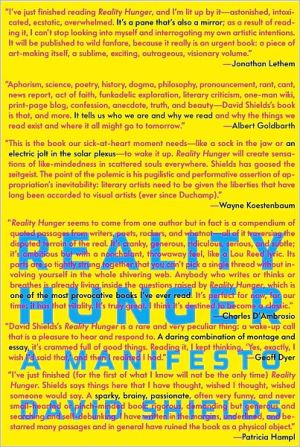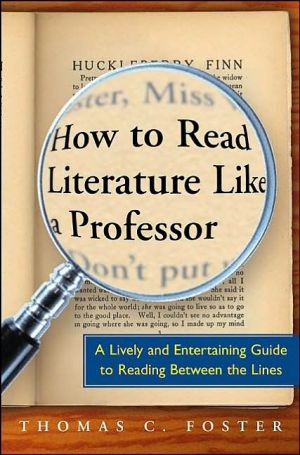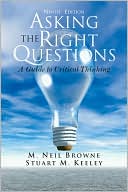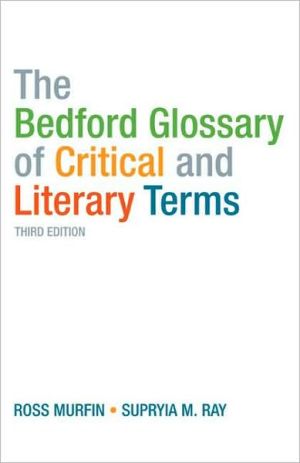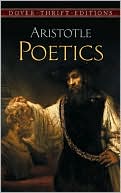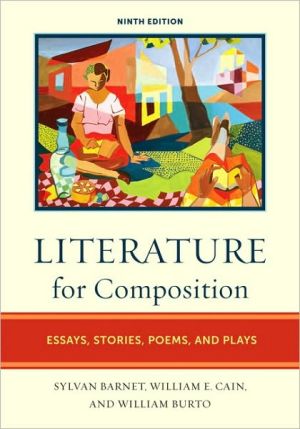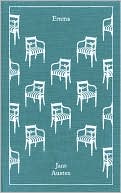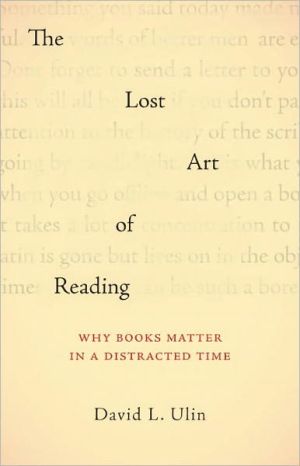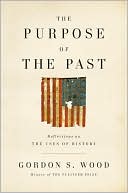Reality Hunger: A Manifesto
An open call for new literary and other art forms to match the complexities of the twenty-first century.\ Reality TV dominates broadband. YouTube and Facebook dominate the web. In Reality Hunger: A Manifesto, his landmark new book, David Shields (author of the New York Times best seller The Thing About Life Is That One Day You’ll Be Dead) argues that our culture is obsessed with “reality” precisely because we experience hardly any.\ Most artistic movements are attempts to figure out a way to...
Search in google:
With this landmark book, David Shields fast-forwards the discussion of the central artistic issues of our time. Who owns ideas? How clear is the distinction between fiction and nonfiction? Has the velocity of digital culture rendered traditional modes obsolete? Exploring these and related questions, Shields orchestrates a chorus of voices, past and present, to reframe debates about the veracity of memoir and the relevance of the novel. He argues that our culture is obsessed with “reality,” precisely because we experience hardly any, and urgently calls for new forms that embody and convey the fractured nature of contemporary experience.The Barnes & Noble ReviewLike any good polemicist, David Shields' ideas are provocative, simple to repeat, and deep in their implications. In Reality Hunger he wastes no time in declaring them: we live amidst a movement of artists "who are breaking larger and larger chunks of 'reality' into their work." These artists pursue a "deliberate unartiness"; theirs is an art that's finely crafted to look "seemingly unprocessed, unfiltered, uncensored, and unprofessional." It's "Zapruder's Super-8 film of the Kennedy assassination," The Eminem Show, the essays of David Foster Wallace, art that's "at once desperate for authenticity and in love with artifice." The reality it offers is one fit for the Internet age: fragmented and frenetic, always questioning the line between fact and fiction, as comfortable with mediation as a second skin, happy to glorify the feeling of reality above reality itself. The ethos of this art is what Shields aims to speak for in Reality Hunger.
Reality Hunger\ A Manifesto \ \ By David Shields \ Knopf\ Copyright © 2010 David Shields\ All right reserved.\ ISBN: 9780307273536 \ \ \ a\ \ overture \ \ 1 \ \ Every artistic movement from the beginning of time is an attempt to figure out a way to smuggle more of what the artist thinks is reality into the work of art. Zola: “Every proper artist is more or less a realist according to his own eyes.” Braque’s goal: “To get as close as I could to reality.” E.g., Chekhov’s diaries, E. M. Forster’s Commonplace Book, Fitzgerald’s The Crack-Up (much his best book), Cheever’s posthumously ?pub?lished journals (same), Edward Hoagland’s journals, Alan ?Bennett’s Writing Home. So, too, every artistic movement or moment needs a credo: Horace’s Ars Poetica, Sir Philip Sid- ney’s Defence of Poesie, André Breton’s “Surrealist Manifesto,” Dogme 95’s “Vow of Chasity.” My intent is to write the ars poetica for a burgeoning group of interrelated (but unconnected) artists in a multitude of forms and media (lyric essay, prose poem, collage novel, visual art, film, television, radio, performance art, rap, stand-up comedy, graffiti) who are breaking larger and larger chunks of “reality” into their work. (Reality, as Nabokov never got tired of reminding us, is the one word that is meaningless without quotationmarks.) \ \ 2 \ \ Jeff Crouse’s plug-in Delete City. The quasi–home movie Open Water. Borat: Cultural Learnings of America for Make Benefit ?Glo?rious Nation of Kazakhstan. Joe Frank’s radio show In the Dark. The depilation scene in The 40-Year-Old Virgin. Lynn Shel- ton’s unscripted film Humpday (“All the writing takes place in the editing room”). Nicholas Barker’s “real-life feature” Unmade Beds, in which actors speak from a script based on interviews they conducted with Barker; the structure is that of a documentary, but a small percentage of the material is made up. Todd Haynes’s Superstar—a biopic of Karen Carpenter that uses Barbie dolls as the principal actors and is available now only as a bootleg video. Curb Your Enthusiasm, which—characteristic of this genre, this ungenre, this antigenre—relies on viewer awareness of the creator’s self-conscious, wobbly manipulation of the gap between person and persona. The Eminem Show, in which Marshall Mathers struggles to metabolize his fame and work through “family of origin” issues (life and/or art?). The Museum of (fictional) Jurassic Technology, which actually exists in Culver City. The (completely fictional) International Necronautical Society’s (utterly serious) “Declaration of Inauthenticity.” So, too, public-access TV, karaoke nights, VH1’s Behind the Music series, “behind-the-scenes” interviews running parallel to the “real” action on reality television shows, rap artists taking a slice of an existing song and building an entirely new song on top of it, DVDs of feature films that inevitably include a documentary on the “making of the movie.” The Bachelor tells us more about the state of unions than any romantic comedy could dream of telling us. The appeal of Billy Collins is that compared with the frequently hieroglyphic obscurantism of his colleagues, his poems sound like they were tossed off in a couple of hours while he drank scotch and listened to jazz late at night (they weren’t; this is an illusion). A Heartbreaking Work of Staggering Genius was full of the same self-conscious apparatus that had bored everyone silly until it got tethered to what felt like someone’s “real life” (even if the author constantly reminded us how fictionalized that life was). At once desperate for authenticity and in love with artifice, I know all the moments are “moments”: staged and theatrical, shaped and thematized. I find I can listen to talk radio in a way that I can’t abide the network news—the sound of human voices waking before they drown. \ \ 3 \ \ An artistic movement, albeit an organic and as-yet-unstated one, is forming. What are its key components? A deliberate unartiness: “raw” material, seemingly unprocessed, unfiltered, uncensored, and unprofessional. (What, in the last half century, has been more influential than Abraham Zapruder’s Super-8 film of the Kennedy assassination?) Randomness, openness to accident and serendipity, spontaneity; artistic risk, emotional urgency and intensity, reader/viewer participation; an overly literal tone, as if a reporter were viewing a strange culture; plasticity of form, pointillism; criticism as autobiography; self-reflexivity, self-ethnography, anthropological autobiography; a blurring (to the point of invisibility) of any distinction between fiction and nonfiction: the lure and blur of the real. \ \ 4 \ \ In most books, the I, or first person, is omitted; in this it will be retained; that, in respect to egotism, is the main difference. We commonly do not remember that it is, after all, always the first person that is speaking. \ \ 5 \ \ It must all be considered as if spoken by a character in a novel (minus the novel). \ \ 6 \ \ I need say nothing, only exhibit. \ \ \ \ z\ \ coda \ \ Part of what I enjoy in documentary is the sense of banditry. To loot someone else’s life or sentences and make off with a point of view, which is called “objective” because one can make anything into an object by treating it this way, is exciting and dangerous. Let us see who controls the danger. \ \ \ Appendix: \ \ 2 Sentence about Unmade Beds: Soyon Im, “The Good, the Bad, and the Ugly,” Seattle Weekly \ 4 Thoreau \ 5 Roland Barthes, Barthes by Barthes (who else would be the author?); “minus the novel”: Michael Dirda, “Whispers in the Darkness,” Washington Post \ 6 Walter Benjamin \ \ 618 Carson, Decreation \ \ Continues... \ \ \ \ Excerpted from Reality Hunger by David Shields Copyright © 2010 by David Shields. Excerpted by permission.\ All rights reserved. No part of this excerpt may be reproduced or reprinted without permission in writing from the publisher.\ Excerpts are provided by Dial-A-Book Inc. solely for the personal use of visitors to this web site. \ \
\ Luc SanteTo call something a manifesto is a brave step. It signals that you are hoisting a flag and are prepared to go down with the ship. David Shields's clarion call may in some ways depart from the usual manifesto profile—it doesn't speak on behalf of a movement, exactly—but it urgently and succinctly addresses matters that have been in the air, have relentlessly gathered momentum and have just been waiting for someone to link them together…[Shields] is a benevolent and broad-minded revolutionary, urging a hundred flowers to bloom, toppling only the outmoded and corrupt institutions. His book may not presage sweeping changes in the immediate future, but it probably heralds what will be the dominant modes in years and decades to come.\ —The New York Times\ \ \ \ \ Publishers WeeklyShields's latest reinvents the "how to" while explaining how the hazy line between truth and lie undermines all forms of modern communication, an understanding that requires accepting the inherent imperfections and idiosyncrasies of a single writer's memory, intent, desire, and point of view. Shields's manifesto reads as a mixture between a diary and lecture-hall notes, each well-thought-out entry (titles include "mimesis," "books for people who find television too slow," "blur," "hip-hop," "in praise of brevity") made up of a series of numbered paragraphs. Incorporated into his consideration of general themes in art are specific pieces of writing and music as well as current events, like the election of Barrack Obama. Shields references a multitude of well-known writers whom he considers definitive (or re-definitive) in literature; one writer that Shields returns to repeatedly is James Frey. Shields considers the Frey debacle, including his guest appearances on Oprah, by way of the imperfect human faculty for memory and communication, finding in Frey's story damning evidence that human beings are doomed to experience life alone. Touching, honest, and dizzyingly introspective, Shields (The Thing About Life is that One Day You'll be Dead) grapples lithely with truth, life, and literature by embracing his unique perspective, and invites each reader to do the same. \ Copyright © Reed Business Information, a division of Reed Elsevier Inc. All rights reserved.\ \ \ Seattle City ArtsReality Hunger is a readable, entertaining, and frequently funny series of observations and pronouncements.\ —Joe Darda\ \ \ \ \ The GuardianThrilling to read, even if you disagree with much of it.\ —Zadie Smith\ \ \ \ \ BookforumAbsorbing, even inspiring. The ideas [David Shields] raises are so important, his ideas are so compelling, that I raved about this book the whole time I was reading it and have regularly quoted it to friends in the weeks since . . . Shields is a funny and sharp writer with a flair for the dramatic. I am grateful for Shields’s sometimes brutal interrogation of what I believe. His critiques led me to reconsider my own creative process.\ —Jami Attenberg\ \ \ \ \ Library JournalShields's tenth book (following The Thing About Life Is That One Day You'll Be Dead) is intended to rock the foundations of the literary world. This "manifesto" is a challenge to the rigid thinking that seeks to define the boundaries of fiction and nonfiction and redefine truth in art in the 21st century. To signal a departure from convention, the 26 chapters are assigned letters of the alphabet rather than numbers. However, numbers are employed to give order to 617 bursts of thought that range from a single line to several pages in length. Among these entries are remarks from such diverse sources as Emily Dickinson, Michael Moore, and Pablo Picasso. Citations for his numerous references are included grudgingly in an appendix on the advice of lawyers. For Shields, not identifying the sources in the text itself is part of the point that he is trying to make. He challenges his readers to reflect on what the popularity of American Idol, Facebook, and Twitter, for example, tell us about the need for new ways of looking at and presenting reality. Shields demonstrates his point about truth when he makes this simple statement: "This sentence is a lie." VERDICT This book will appeal to a limited audience interested in a modernist view of literary criticism. [See Prepub Alert, LJ 10/1/09.]—Anthony Pucci, Notre Dame H.S., Elmira, NY\ \ \ \ \ Kirkus ReviewsThe subtitle of David Shields' Reality Hunger categorizes it as "a manifesto," which is a little like calling a nuclear bomb "a weapon." In a series of numbered paragraphs, Shields explodes all sorts of categorical distinctions-between fiction and nonfiction, originality and plagiarism, memoir and fabrication, reality and perception. It's a book designed to inspire and to infuriate, and it is sure to do both. In an era of hip-hop sampling, James Frey, artistic collage and the funhouse mirror of so-called "reality TV," Shields maintains that so many of the values underpinning cultural conventions are at best anachronisms and at worst lies. And he does so in audacious fashion, taking quotes from myriad sources, removing the quotation marks, attribution and context, leaving the reader to wonder what is original to Shields and what he has appropriated from others. "Anything that exists in the culture is fair game to assimilate into a new work," writes Shields (or someone). He later explains his methodology: "Most of the passages in this book are taken from other sources. Nearly every passage I've clipped I've also revised, at least a little-for the sake of compression, consistency or whim."The mash-up results in a coherent, compelling argument, a work of original criticism that consistently raises provocative questions about the medium it employs. It asks whether everything we know is provisional-and then asks who's asking that question, or if such authorship even matters. At his publisher's insistence, Shields includes an appendix of sources for each citation, but urges the reader not to consult it: "Your uncertainty about whose words you've just read is not a bug but a feature," he insists."A major focus of Reality Hunger is appropriation and plagiarism and what these terms mean. I can hardly treat the topic deeply without engaging in it."Shields' argument isn't a lone howl from the wilderness. Novelist Jonathan Lethem employed a similar technique in his February 2007 essay for Harper's ("The Ecstasy of Influence: A Plagiarism"). Bob Dylan's recent releases have invited copyright sleuths to trace the origins of work he presents as original. The artist who bills himself as Girl Talk has built a musical career on aural appropriation kindred to Shields'. As nonfiction increasingly verges on novelistic narrative and fiction continues to draw inspiration from "real life" (whatever that is), as computer technology makes cut-and-paste far easier than William Burroughs ever imagined, as the same image of Barack Obama informs both Shepard Fairey's art and an AP photographer's journalism ("a watershed moment for appropriation art," according to Shields), the formerly firm foundations of ethical distinctions find themselves crumbling. Or were those foundations ever as firm as we believed? " ‘Fiction'/‘nonfiction' " is an utterly useless distinction," states Reality Hunger. How so? "An awful lot of fiction is immensely autobiographical, and a lot of nonfiction is highly imagined. We dream ourselves awake every minute of the day."Author tour to Boston, New York, Portland, Ore., San Francisco, Seattle\ \ \ \ \ The Barnes & Noble ReviewLike any good polemicist, David Shields' ideas are provocative, simple to repeat, and deep in their implications. In Reality Hunger he wastes no time in declaring them: we live amidst a movement of artists "who are breaking larger and larger chunks of 'reality' into their work." These artists pursue a "deliberate unartiness"; theirs is an art that's finely crafted to look "seemingly unprocessed, unfiltered, uncensored, and unprofessional." It's "Zapruder's Super-8 film of the Kennedy assassination," The Eminem Show, the essays of David Foster Wallace, art that's "at once desperate for authenticity and in love with artifice." The reality it offers is one fit for the Internet age: fragmented and frenetic, always questioning the line between fact and fiction, as comfortable with mediation as a second skin, happy to glorify the feeling of reality above reality itself. The ethos of this art is what Shields aims to speak for in Reality Hunger.\ A spokesman must know how to convey his message without coming off as dull or condescending, and in Reality Hunger Shields uses a tried-and-true method to do so: the book itself exemplifies the very art it means to dissect. It consists of 617 aphorism-like fragments that range from a sentence to a paragraph in length, loosely grouped into 26 sections under headings like "mimesis" and "collage." Arranged to suggest connections but lacking the tissue to make these connections palpable, the fragments create an invigorating reading experience because each one incites us to think -- rather than doing the thinking for us.\ Part of the genius -- and the treat -- of Reality Hunger is that Shields gladlydisregards boundaries, whether temporal, cultural, or artistic. Leapfrogging across centuries, continents, and cultures, the book feels sweeping and concise, timeless and timely all at once. That Shields' deconstructions-by-fragment absorb contemporary phenomena like James Frey, hip-hop, and J.T. LeRoy makes it clear that he is interested in our particular historical moment, yet his ability to trace commonalities across cultures and centuries suggests the more fundamental ideas linking our "reality hunger" with previous eras. Thus in fragment 10 we start in Rome, circa the 2nd century B.C., with Terence: "There's nothing to say that hasn't been said before." A few pages later fragment 32 informs us that "the word novel, when it entered the languages of Europe . . . meant the form of writing that was formless, had no rules", and then just a few pages after that fragment 38 seems to prefigure the modernist novel: "Emerson called the new literature he'd been looking to 'a panharmonicon. Here everything is admissible -- philosophy, ethics, divinity, criticism, poetry, humor . . .'"\ In charting this progression, is Shields arguing that writing has continually embraced formlessness as a way of making it new? Or perhaps he's claiming that as human knowledge has expanded, writers have had to create new forms to integrate it into their works. Yet how would your answer change if I showed you fragment 53: "Suddenly everyone's tale is tellable, which seems to me a good thing, even if not everyone's story turns out to be fascinating or well told."\ Reality Hunger is such a kinetic read because it's continually opening itself to new possibilities. Though the book can be read straight through, its network-like form works best when readers order the 26 sections as they choose. Shields would likely smile approvingly at such a reading: in a nod to the creative commons that is essential to all art -- and perhaps also as an acknowledgment that his thesis is more novel for its assemblage than its constituent parts -- most of these fragments are quotes whose only attribution comes at the back of the book. Those who insist on knowing everything can spoil the fun and flip back to see which fragments are Shields' and which are not (though Shields' source notes are often purposively vague). These same people will be bothered that Reality Hunger is more of a breathless incitement than a laborious tract; the rest of us can enjoy the rush of thought as we scoop up fragment after addictive fragment and revel in Shields' uninhibited free-flow of ideas. That, after all, is the joy of reading this wonderfully inconclusive provocation. Shields' collage-like book seethes with the electricity of the possible, -- on every page it evokes that wonderful feeling that comes just before the synapse fires and your brain lights up in thought. It makes one hungry to discover the art that lives up to this thrilling manifesto.\ --Scott Esposito\ \ \
